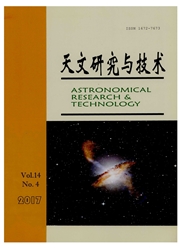

 中文摘要:
中文摘要:
统计分析了太阳活动周下降段(2003~2005年)发生的76个共生CME的射电爆发事件。射电爆发资料来自国家天文台和Culgoora的微波和米波频谱仪。在76个事件中有50个快速CME和26个慢速CME。从中发现,快速CME和慢速CME的产率分别随着太阳活动周的降低而下降和上升,这可能说明CME的产率与太阳活动周中日冕磁结构的位形和位置变化有关。同时也发现,射电爆发的类型和寿命有一个变化规律,即随着频率的降低射电爆发的寿命变长,此特征支持了伴生CME的Ⅱ型爆发统一模型的思想。另外还发现在厘米一分米波范围,CME开始前后,容易发生射电Ⅲ型爆发或快速精细结构。这说明射电辐射的精细结构可能是CME的前兆现象或CME早期发展阶段由于磁重联引发的低日冕小尺度磁扰动的结果。
 英文摘要:
英文摘要:
We statistically analyze 76 radio-burst events associated with CME events during the period of 2003 - 2005, which is in the descending phase of solar activity cycle. The radio data are within the frequency range of 18 MHz to 7 200 MHz and are obtained from the LACSO/SOHO or the spectrometers of Culgoora and NAOC (National Astronomical Observatories of China). Out of the 76 events 50 and 26 are fast and slow, respectively. We find that the fractions of fast and slow CME events decrease and increase in the descending phase of solar activity cycle, respectively. This is possibly because of the correlation of the frequencies of CME events with the variations of structures and positions of solar magnetic fields during the solar activity cycle. Furthermore, we find a trend for types and durations of radio bursts. The durations decrease with the radio frequencies. The trend supports the idea of a unified model about type-Ⅱ radio bursts associated with CMEs. In addition, we find that type-Ⅲ bursts or fast fine structures (FS) frequently occur in the wavelength range of centimeters to meters just before or after the CMEs start. The radio FS could be interpreted as precursor phenomena of the CMEs or as the results of small-scale magnetic disturbances in the lower corona caused by magnetic reeonnections during the early phases of the CMEs.
 同期刊论文项目
同期刊论文项目
 同项目期刊论文
同项目期刊论文
 期刊信息
期刊信息
